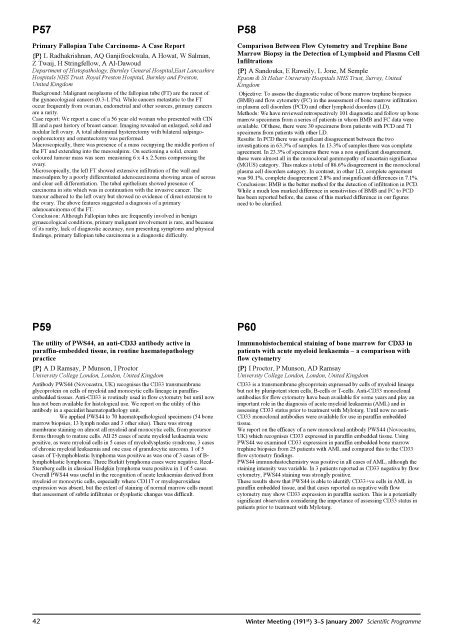2007 Winter Meeting - London - The Pathological Society of Great ...
2007 Winter Meeting - London - The Pathological Society of Great ...
2007 Winter Meeting - London - The Pathological Society of Great ...
- No tags were found...
You also want an ePaper? Increase the reach of your titles
YUMPU automatically turns print PDFs into web optimized ePapers that Google loves.
P57Primary Fallopian Tube Carcinoma- A Case Report{P} L Radhakrishnan, AQ Ganjifrockwala, A Howat, W Salman,Z Twaij, H Stringfellow, A Al-DawoudDepartment <strong>of</strong> Histopathology, Burnley General Hospital,East LancashireHospitals NHS Trust. Royal Preston Hospital, Burnley and Preston,United KingdomBackground: Malignant neoplasms <strong>of</strong> the fallopian tube (FT) are the rarest <strong>of</strong>the gynaecological cancers (0.3-1.1%). While cancers metastatic to the FToccur frequently from ovarian, endometrial and other sources, primary cancersare a rarity.Case report: We report a case <strong>of</strong> a 56 year old woman who presented with CINIII and a past history <strong>of</strong> breast cancer. Imaging revealed an enlarged, solid andnodular left ovary. A total abdominal hysterectomy with bilateral salpingooophorectomyand omentectomy was performed.Macroscopically, there was presence <strong>of</strong> a mass occupying the middle portion <strong>of</strong>the FT and extending into the mesosalpinx. On sectioning a solid, creamcoloured tumour mass was seen measuring 6 x 4 x 2.5cms compressing theovary.Microscopically, the left FT showed extensive infiltration <strong>of</strong> the wall andmesosalpinx by a poorly differentiated adenocarcinoma showing areas <strong>of</strong> serousand clear cell differentiation. <strong>The</strong> tubal epithelium showed presence <strong>of</strong>carcinoma in situ which was in continuation with the invasive cancer. <strong>The</strong>tumour adhered to the left ovary but showed no evidence <strong>of</strong> direct extension tothe ovary. <strong>The</strong> above features suggested a diagnosis <strong>of</strong> a primaryadenocarcinoma <strong>of</strong> the FT.Conclusion: Although Fallopian tubes are frequently involved in benigngynaecological conditions, primary malignant involvement is rare, and because<strong>of</strong> its rarity, lack <strong>of</strong> diagnostic accuracy, non presenting symptoms and physicalfindings, primary fallopian tube carcinoma is a diagnostic difficulty.P58Comparison Between Flow Cytometry and Trephine BoneMarrow Biopsy in the Detection <strong>of</strong> Lymphoid and Plasma CellInfiltrations{P} A Sandouka, E Raweily, L Jone, M SempleEpsom & St Helier University Hospitals NHS Trust, Surrey, UnitedKingdomObjective: To assess the diagnostic value <strong>of</strong> bone marrow trephine biopsies(BMB) and flow cytometry (FC) in the assessment <strong>of</strong> bone marrow infiltrationin plasma cell disorders (PCD) and other lymphoid disorders (LD).Methods: We have reviewed retrospectively 101 diagnostic and follow up bonemarrow specimens from a series <strong>of</strong> patients in whom BMB and FC data wereavailable. Of these, there were 30 specimens from patients with PCD and 71specimens from patients with other LD.Results: In PCD there was significant disagreement between the twoinvestigations in 63.3% <strong>of</strong> samples. In 13.3% <strong>of</strong> samples there was completeagreement. In 23.3% <strong>of</strong> specimens there was a non significant disagreement,these were almost all in the monoclonal gammopathy <strong>of</strong> uncertain significance(MGUS) category. This makes a total <strong>of</strong> 86.6% disagreement in the monoclonalplasma cell disorders category. In contrast, in other LD, complete agreementwas 90.1%, complete disagreement 2.8% and insignificant differences in 7.1%.Conclusions: BMB is the better method for the detection <strong>of</strong> infiltration in PCD.While a much less marked difference in sensitivities <strong>of</strong> BMB and FC to PCDhas been reported before, the cause <strong>of</strong> this marked difference in our figuresneed to be clarified.P59<strong>The</strong> utility <strong>of</strong> PWS44, an anti-CD33 antibody active inparaffin-embedded tissue, in routine haematopathologypractice{P} A D Ramsay, P Munson, I ProctorUniversity College <strong>London</strong>, <strong>London</strong>, United KingdomAntibody PWS44 (Novocastra, UK) recognises the CD33 transmembraneglycoprotein on cells <strong>of</strong> myeloid and monocytic cells lineage in paraffinembeddedtissues. Anti-CD33 is routinely used in flow cytometry but until nowhas not been available for histological use. We report on the utility <strong>of</strong> thisantibody in a specialist haematopathology unit.We applied PWS44 to 70 haematopathological specimens (54 bonemarrow biopsies, 13 lymph nodes and 3 other sites). <strong>The</strong>re was strongmembrane staining on almost all myeloid and monocytic cells, from precursorforms through to mature cells. All 25 cases <strong>of</strong> acute myeloid leukaemia werepositive, as were myeloid cells in 5 cases <strong>of</strong> myelodysplastic syndrome, 3 cases<strong>of</strong> chronic myeloid leukaemia and one case <strong>of</strong> granulocytic sarcoma. 1 <strong>of</strong> 5cases <strong>of</strong> T-lymphoblastic lymphoma was positive as was one <strong>of</strong> 3 cases <strong>of</strong> B-lymphoblastic lymphoma. Three Burkitt lymphoma cases were negative. Reed-Sternberg cells in classical Hodgkin lymphoma were positive in 1 <strong>of</strong> 5 cases.Overall PWS44 was useful in the recognition <strong>of</strong> acute leukaemias derived frommyeloid or monocytic cells, especially where CD117 or myeloperoxidaseexpression was absent, but the extent <strong>of</strong> staining <strong>of</strong> normal marrow cells meantthat assessment <strong>of</strong> subtle infiltrates or dysplastic changes was difficult.P60Immunohistochemical staining <strong>of</strong> bone marrow for CD33 inpatients with acute myeloid leukaemia – a comparison withflow cytometry{P} I Proctor, P Munson, AD RamsayUniversity College <strong>London</strong>, <strong>London</strong>, United KingdomCD33 is a transmembrane glycoprotein expressed by cells <strong>of</strong> myeloid lineagebut not by pluripotent stem cells, B-cells or T-cells. Anti-CD33 monoclonalantibodies for flow cytometry have been available for some years and play animportant role in the diagnosis <strong>of</strong> acute myeloid leukaemia (AML) and inassessing CD33 status prior to treatment with Mylotarg. Until now no anti-CD33 monoclonal antibodies were available for use in paraffin embeddedtissue.We report on the efficacy <strong>of</strong> a new monoclonal antibody PWS44 (Novocastra,UK) which recognises CD33 expressed in paraffin embedded tissue. UsingPWS44 we examined CD33 expression in paraffin embedded bone marrowtrephine biopsies from 25 patients with AML and compared this to the CD33flow cytometry findings.PWS44 immunohistochemistry was positive in all cases <strong>of</strong> AML, although thestaining intensity was variable. In 3 patients reported as CD33 negative by flowcytometry, PWS44 staining was strongly positive.<strong>The</strong>se results show that PWS44 is able to identify CD33+ve cells in AML inparaffin embedded tissue, and that cases reported as negative with flowcytometry may show CD33 expression in paraffin section. This is a potentiallysignificant observation considering the importance <strong>of</strong> assessing CD33 status inpatients prior to treatment with Mylotarg.42 <strong>Winter</strong> <strong>Meeting</strong> (191 st ) 3–5 January <strong>2007</strong> Scientific Programme













